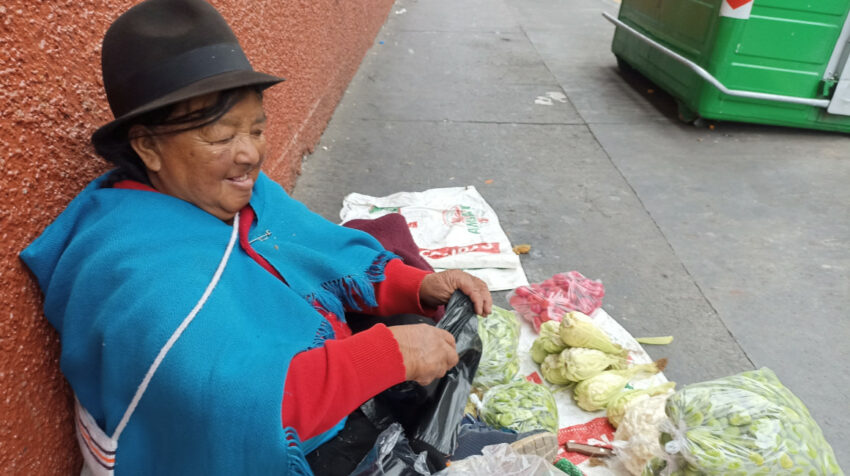The migration of young people in Ecuador could lead to a future where the agricultural sector faces a significant shortage of labor resources.
The serene landscapes of Tungurahua, once bustling with the energy of youth engaged in agricultural endeavors, now bear a weighty concern for local authorities as almost 60% of the younger generation has migrated to distant lands. While this exodus promises a brighter future for those who depart, it casts a long shadow on the elderly population left behind in the verdant fields.
The migration phenomenon has, in essence, transformed the elderly into inadvertent custodians of the land they once shared with generations past. The deeply lined faces and hands, weathered and tanned by years of tireless plowing, stand as a testament to their unceasing toil to maintain the fields’ productivity.
For these older adults, the memory of bidding farewell to their children and grandchildren lingers heavily in their hearts. These young souls, in search of prosperity beyond the fields, have embarked on journeys to distant countries. Regrettably, for some, the prospect of a reunion has dwindled into the realm of hopelessness.
Left behind
Elsa Galarza, 60, possesses a small plot of land in the Santa Rosa parish. While her offspring now labor in the United States, she remains rooted in her homeland, her age preventing her from pursuing the risky venture herself. Despite the separation, she finds solace in the knowledge that her kin are prospering overseas.
Reflecting on her own situation, Elsa laments the distance that has severed her from her loved ones. In 2022, a smuggler offered her children passage to the United States, contingent upon the entire family’s financial participation. They pooled resources, accumulating a staggering $60,000 in credits to fund their collective journey. Elsa, a widow, was compelled to remain behind with a sister. In the ensuing months, she grappled with sleepless nights, diminished appetite, and emotional turmoil.
“I didn’t know anything about my children, that worried me more than having to assume the debt in the savings cooperatives. It was very difficult; I went into depression. I had to work twice as hard, even though I no longer had any hands to help me,” she recalls. Now my children are working and help me.”
Elsa’s plight is mirrored by many other senior citizens in Tungurahua’s rural communities. In this evolving landscape, the older generation has assumed the mantle of guardianship, nurturing both the land and their own well-being.
By 2022, the Ministry of Economy and Social Inclusion (MIES) had extended support to around 6,161 older adults in Tungurahua. Yet, many among them felt forsaken, left to navigate their twilight years alone. Carmen, aged 72, epitomizes this reality. Her family, including a son, two grandchildren, and a daughter-in-law, have sought fortunes in the United States, leaving Carmen to grapple with daily survival.
Once, the fields of Tungurahua thrived as sources of livelihood and prosperity. Farmers like Carmen would plant their crops and take pride in vending their produce at local fairs. However, the dynamics have shifted, and the primary objective is now sustenance. With tears in her eyes, Carmen recollects the heart-wrenching farewell of 2021, the year her family embarked on their journey.
A similar narrative echoes in other corners of Tungurahua, particularly in neighborhoods like Tisaleo, which has borne the brunt of migration. Mario Valarezo speaks of how the once-vibrant community has been ravaged by this phenomenon. The consequences loom large: a dearth of able-bodied individuals to cultivate the fields, as the older generation, their vigor waning, shoulders the responsibility.
A telling vignette of this reality unfolds at the strawberry and blackberry fair in Tisaleo, a weekly event where aging producers make their presence felt. Yolanda Aliaga, a vendor, recognizes the vital role played by these elderly individuals, whose once-daily tasks have now become a cornerstone of survival.
“Being active does them good. But the sad thing is that they are left alone, without anyone taking care of them,” said Aliaga.
Jaime Pacha, an indigenous leader, underscores the statistics—60% of the youth in communities like Mogato, Punguloma, and Cuatro Esquinas de Quisapincha have migrated. This vacuum threatens to erode the region’s agricultural heritage, and the burden to mitigate this crisis falls on shoulders ill-equipped to bear it.
The Tungurahua Parochial Governments, under the leadership of Amable Chaluis, strive to collaborate with MIES. Their joint efforts aim to target vulnerable pockets and extend assistance where needed most. The hope is to restore dignity and support to those who have been unintentionally left behind.


0 Comments